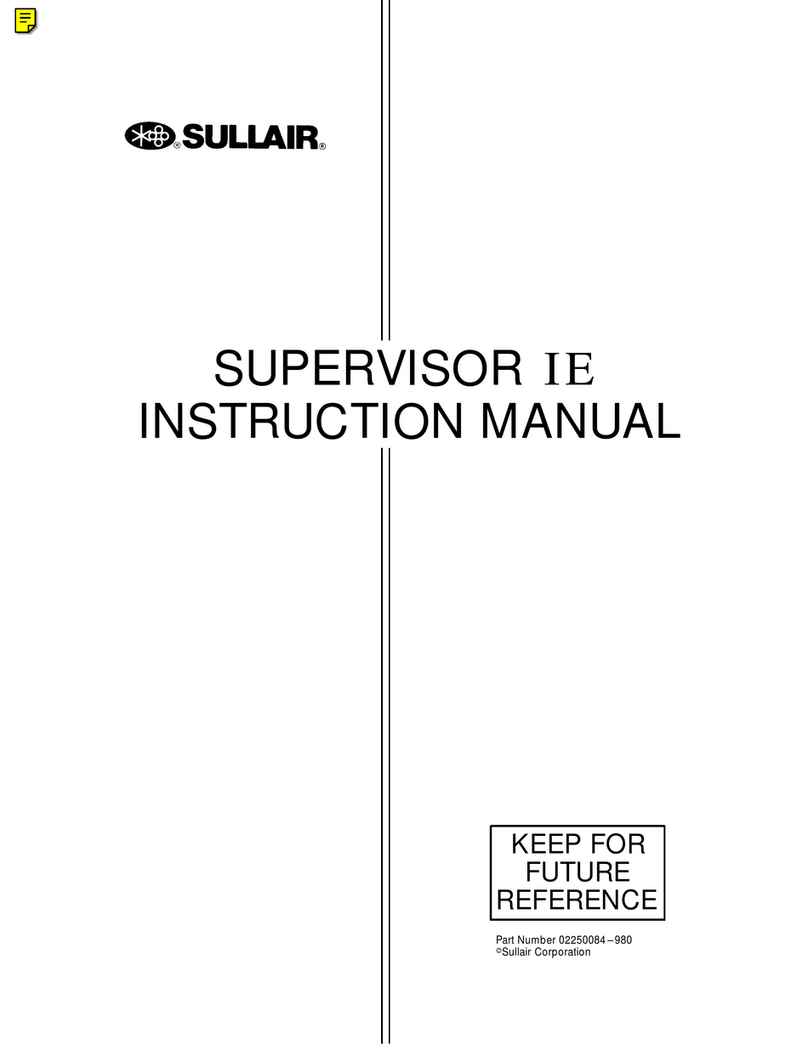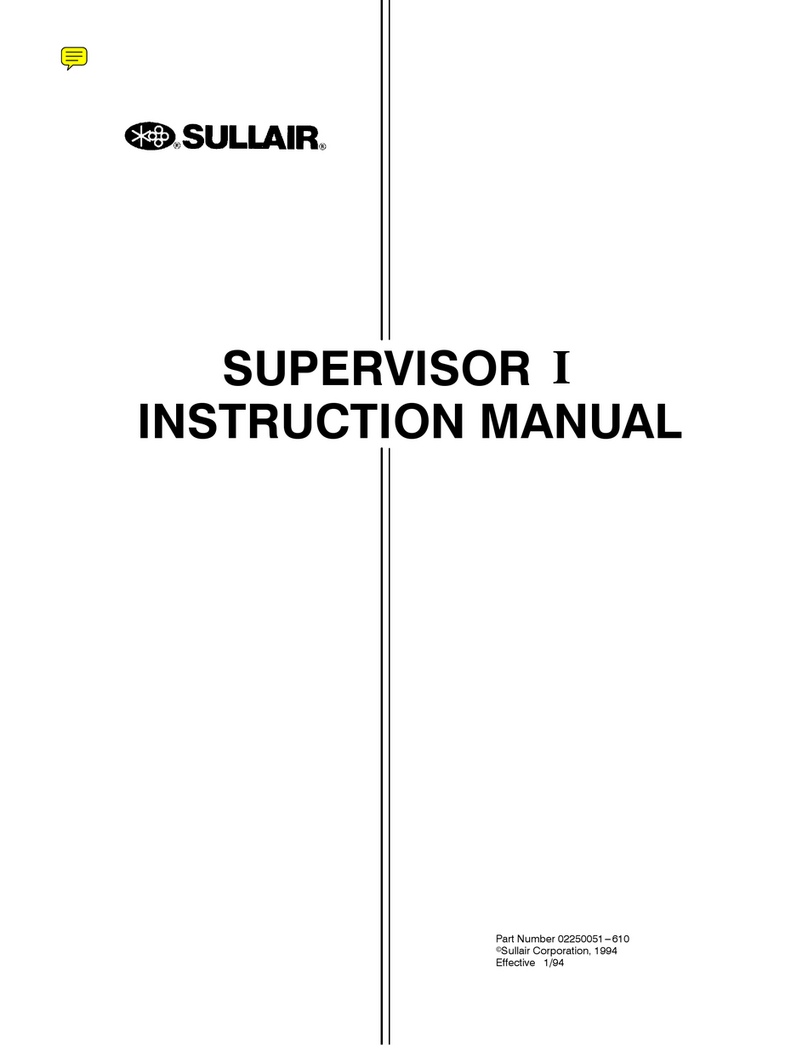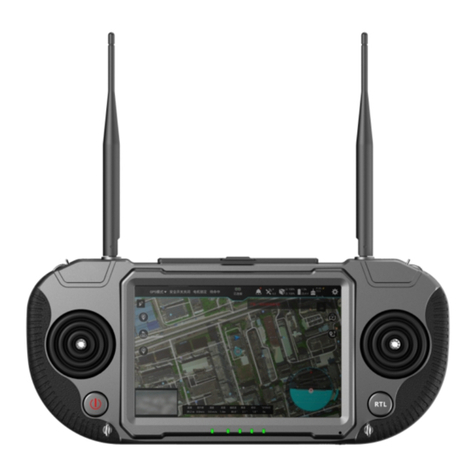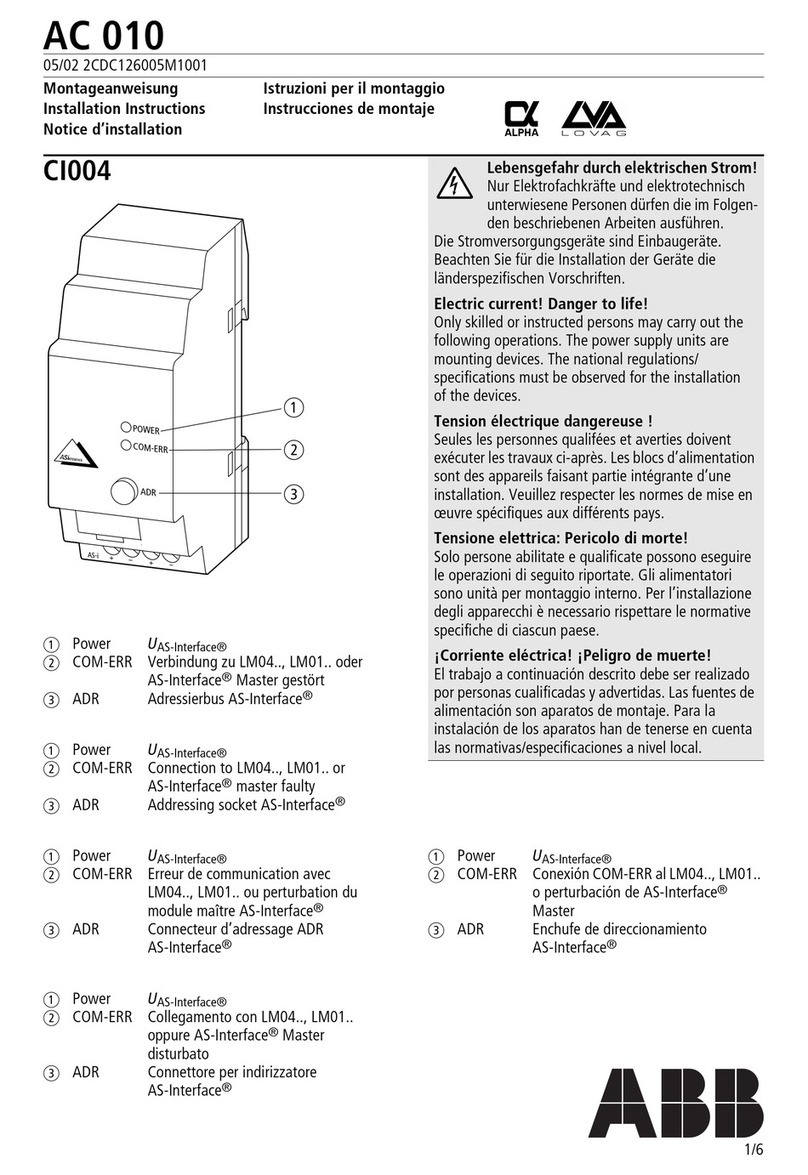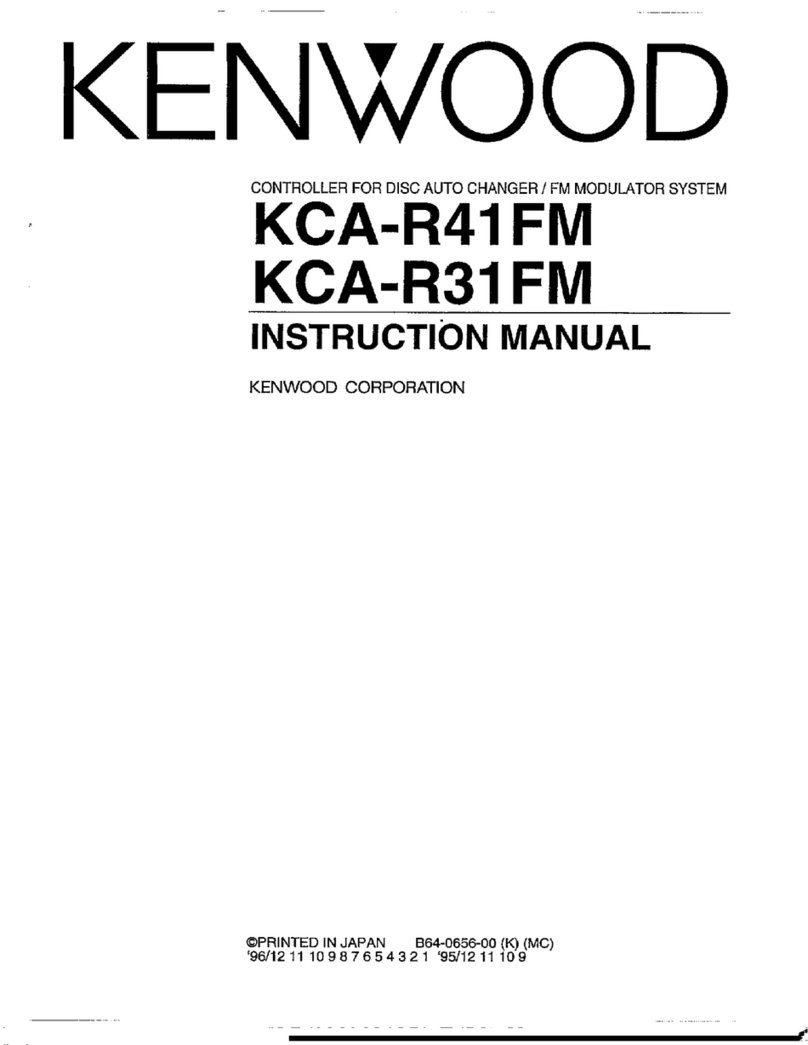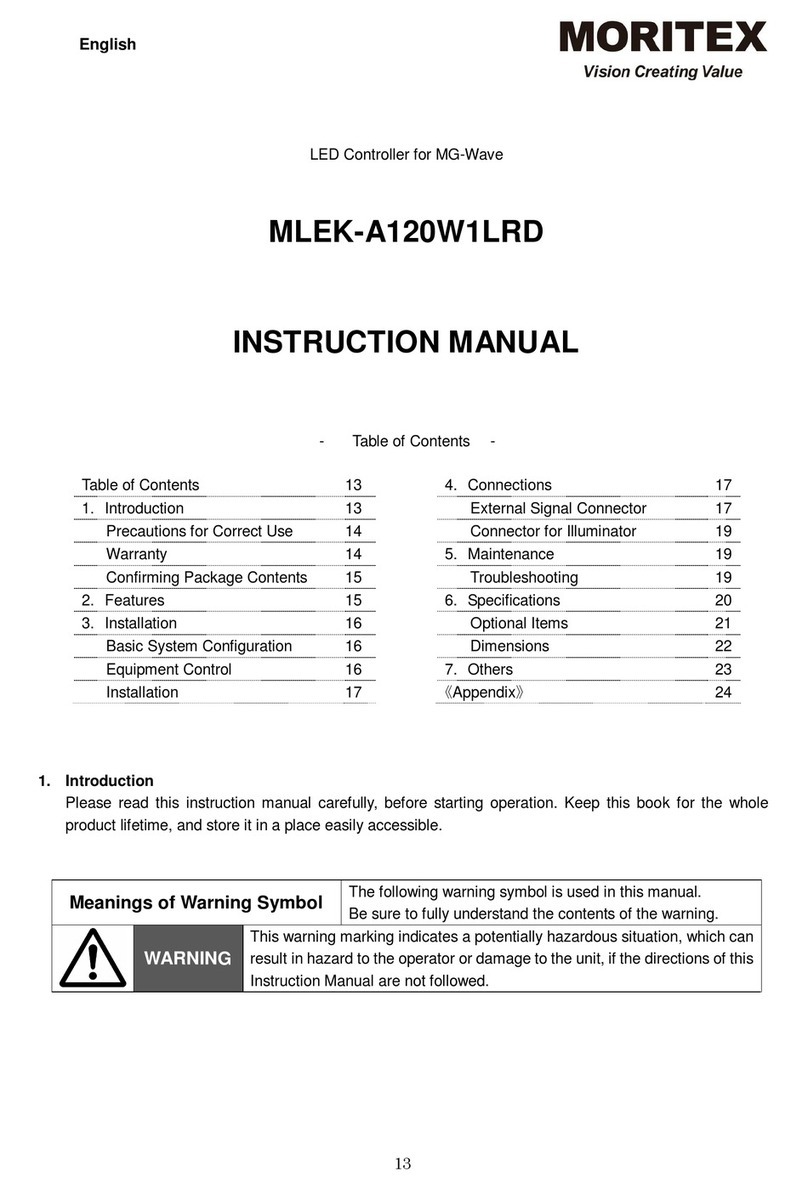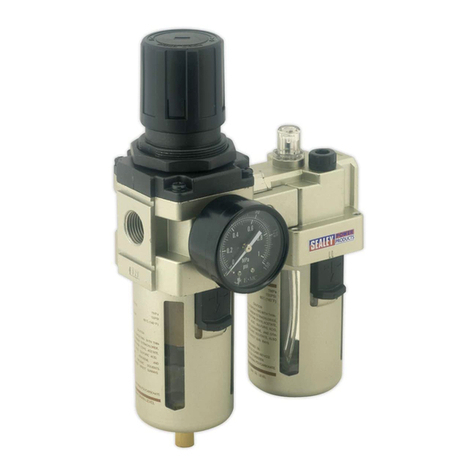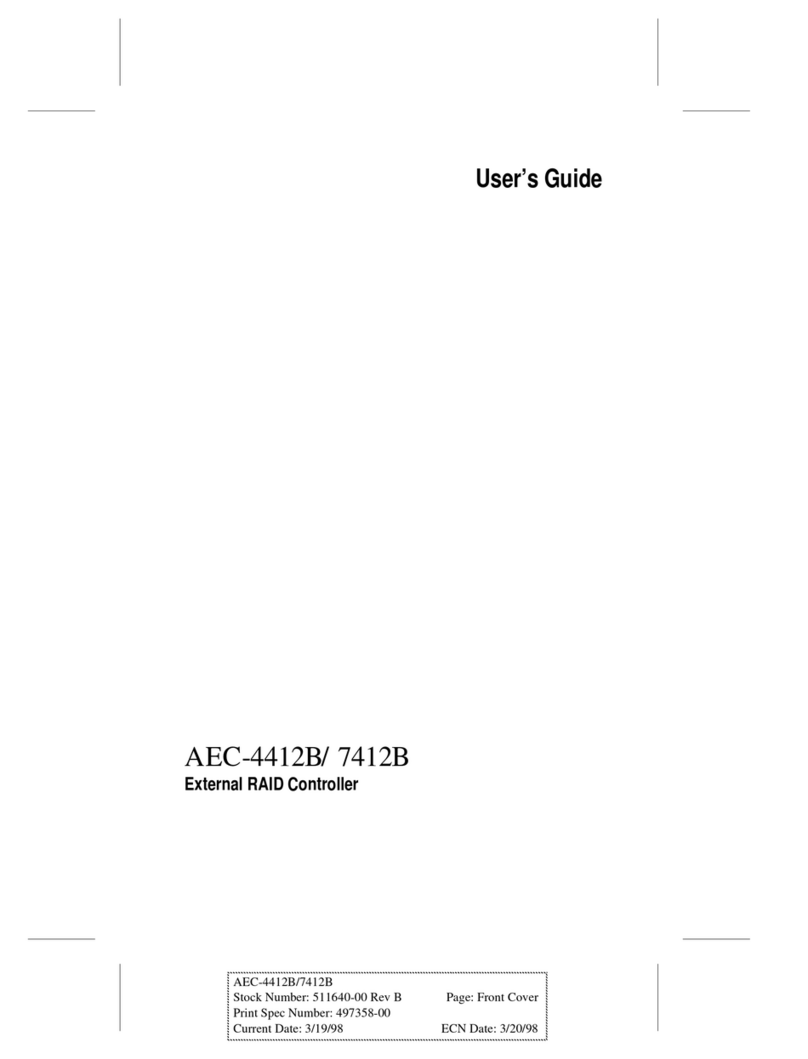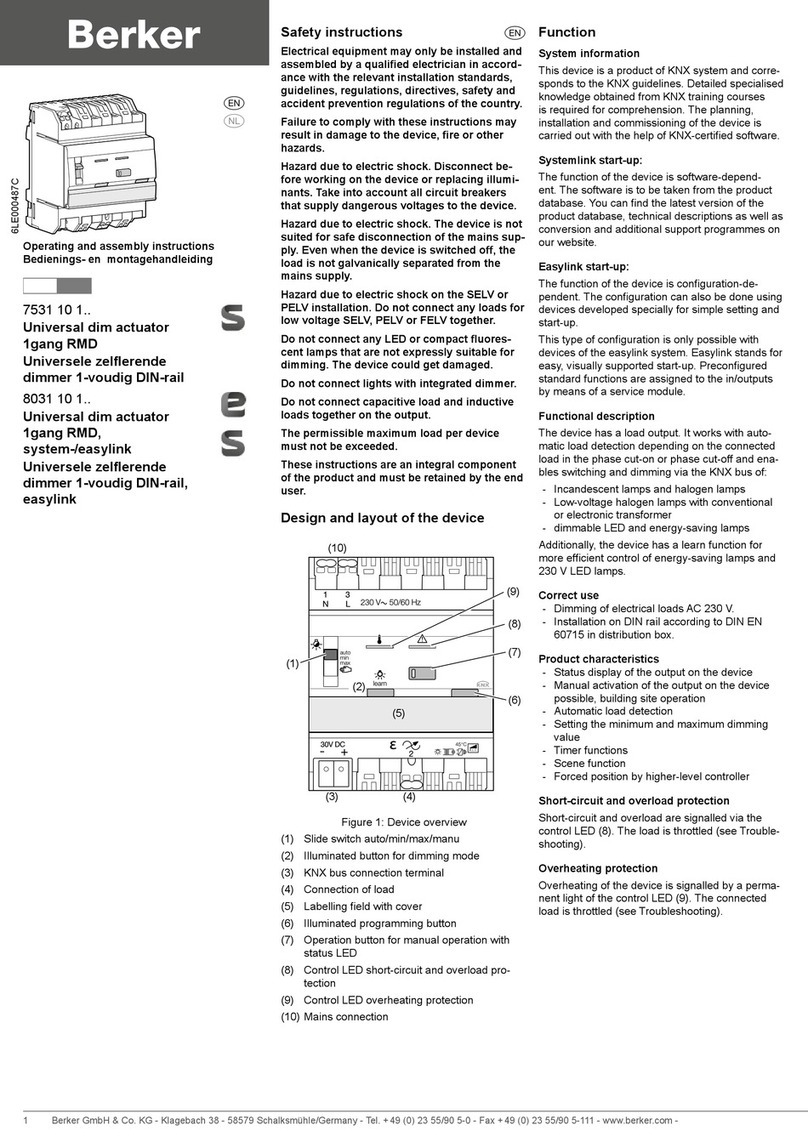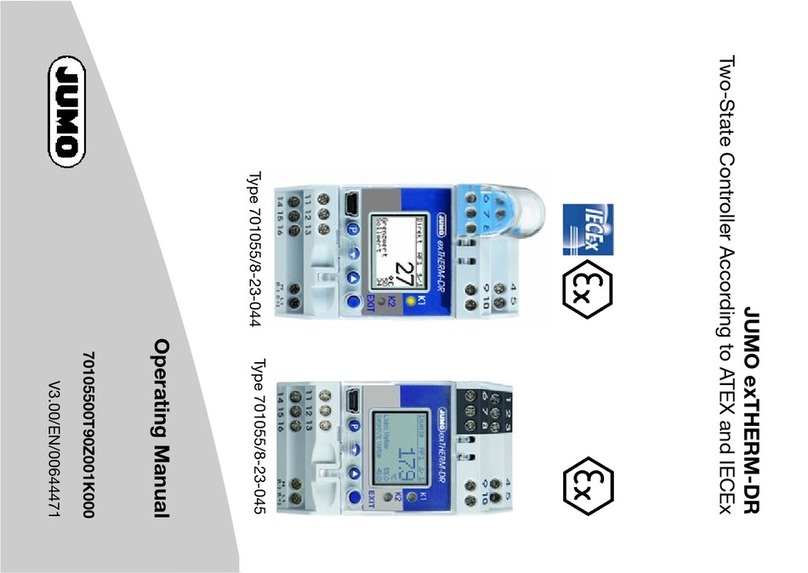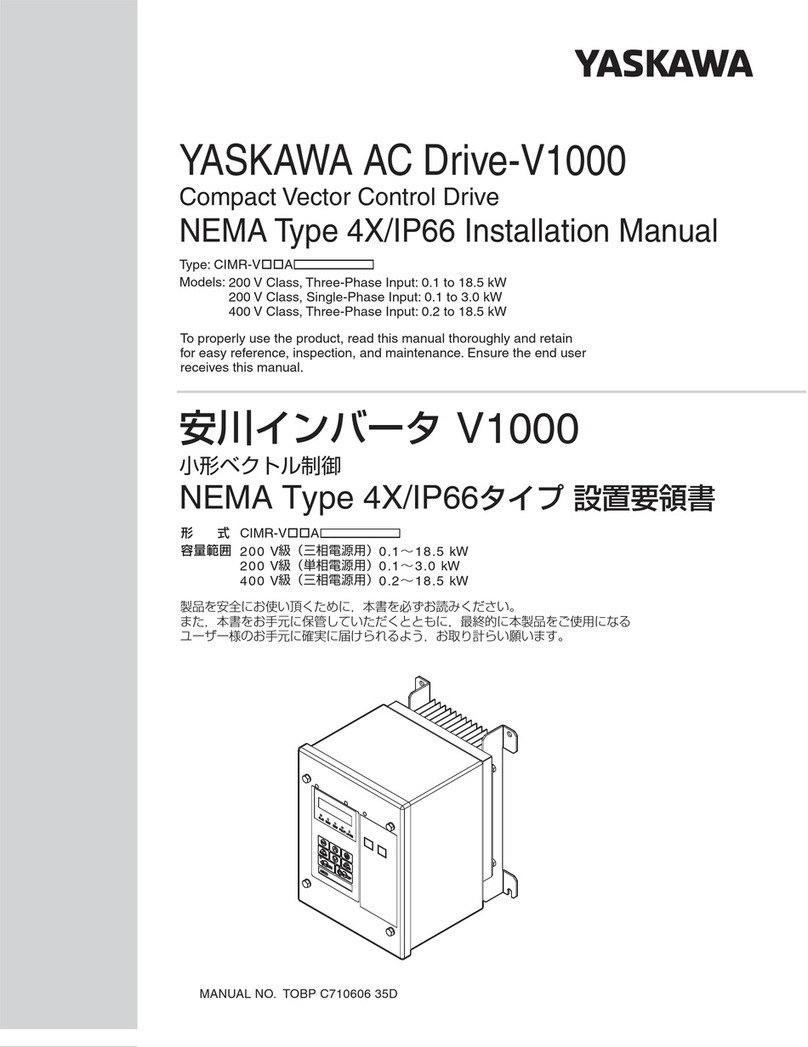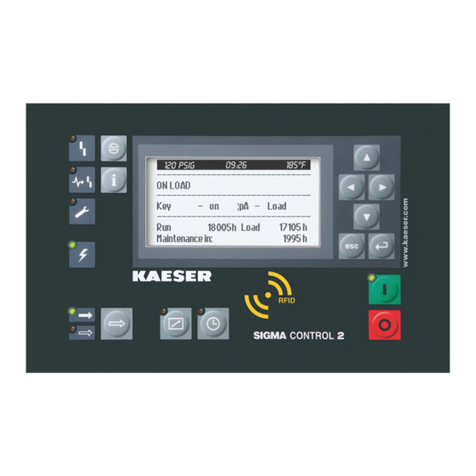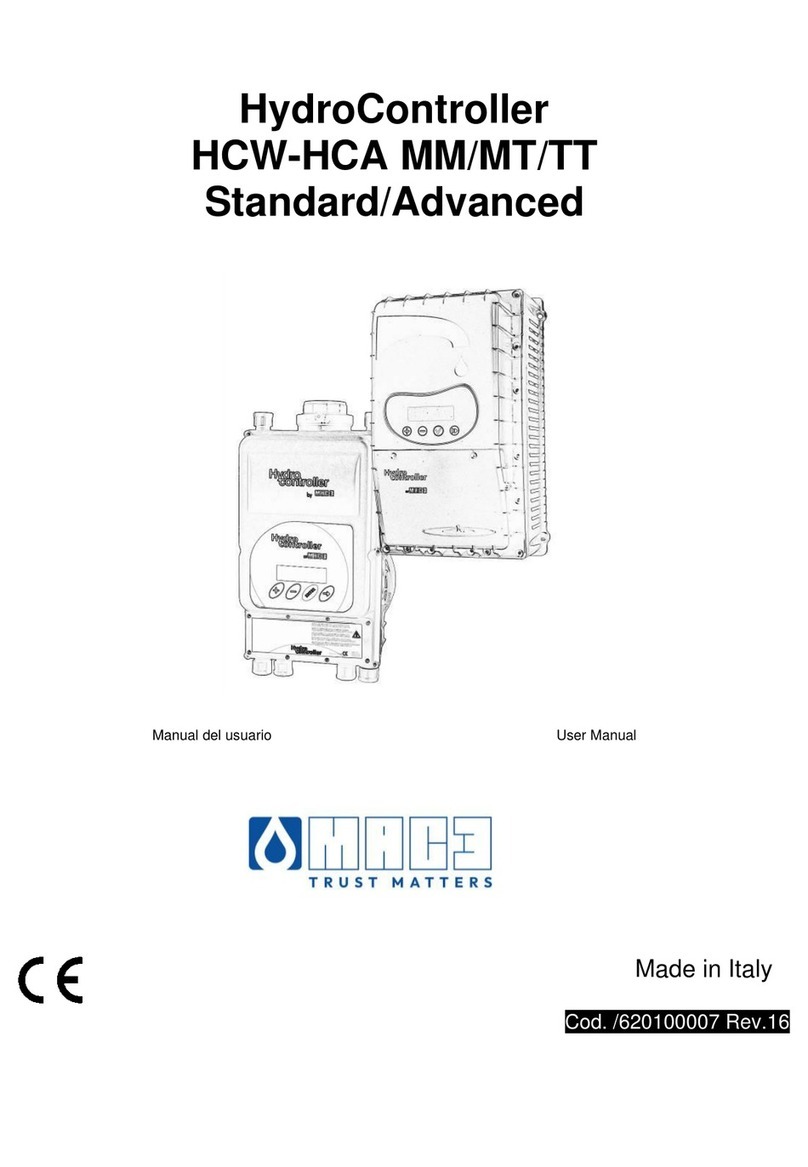Sullair 900 User manual

Failure to follow the instructions
and procedures in this manual or,
misuse of this equipement will
VOID its warranty!
WARRANTY NOTICE
PART NUMBER:
KEEP FOR
FUTURE
REFERENCE
USER MANUAL
©SULLAIR CORPORATION
The information in this manual is current
as of its publication date, and applies to
compressor serial number:
and all subsequent serial numbers.
02250201-742 R00
201200000
900/1600 IT4 CONTROLLER

AIR CARE SEMINAR TRAINING
Sullair Air Care Seminars are courses that provide hands-on instruction for the proper operation, maintenance,
and servicing of Sullair products. Individual seminars on portable compressors and compressor electrical
systems are offered at regular intervals throughout the year at Sullair’s corporate headquarters training facility
located at Michigan City, Indiana.
Instruction includes training on the function and installation of Sullair service parts, troubleshooting common
faults and malfunctions, and actual equipment operation. These seminars are recommended for maintenance,
contractor maintenance, and service personnel.
For detailed course outlines, schedule, and cost information contact:
SULLAIR TRAINING DEPARTMENT
1-888-SULLAIR or
219-879-5451 (ext. 5623)
www.sullair.com
- Or Write -
Sullair Corporation
3700 E. Michigan Blvd.
Michigan City, IN 46360
Attn: Service Training Department.

TABLE OF CONTENTS
SECTION 1—SAFETY
5 1.1 GENERAL
5 1.2 TOWING
8 1.3 PRESSURE RELEASE
9 1.4 FIRE AND EXPLOSION
10 1.5 MOVING PARTS
11 1.6 HOT SURFACES, SHARP EDGES AND SHARP CORNERS
11 1.7 TOXIC AND IRRITATING SUBSTANCES
12 1.8 ELECTRICAL SHOCK
12 1.9 LIFTING
13 1.10 ENTRAPMENT
13 1.11 JUMP STARTING
14 1.12 IMPLEMENTATION OF LOCKOUT/TAGOUT
15 1.13 CALIFORNIA PROPOSITION 65
16 1.14 SYMBOLS AND REFERENCES
SECTION 2—STARTUP PROCEDURES
19 2.1 INTRODUCTION
19 2.2 COMPASS CONTROLLER PANEL LAYOUT
19 2.3 COMPASS CONTROLLER POWER UP
20 2.4 INSTRUMENT PANEL GROUP, FUNCTIONAL DESCRIPTION
21 2.5 NORMAL OPERATION
SECTION 3—ADJUSTMENT PROCEDURE
23 3.1 INTRODUCTION
24 3.2 SETTINGS AND DIAGNOSTIC
SECTION 4—DESCRIPTION
33 4.1 INTRODUCTION
33 4.2 OPERATING MODES

Section 1
5
SAFETY
1.1 GENERAL
Sullair Corporation designs and manufactures all of
its products so they can be operated safely.
However, the responsibility for safe operation rests
with those who use and maintain these products. The
following safety precautions are offered as a guide
which, if conscientiously followed, will minimize the
possibility of accidents throughout the useful life of
this equipment. Read the CIMA Safety Manual
prior to compressor operation and towing, if
applicable in your area.
The air compressor should be operated only by those
who have been trained and delegated to do so, and
who have read and understood this Operator’s
Manual. Failure to follow the instructions, procedures
and safety precautions in this manual can result in
accidents and injuries.
NEVER start the air compressor unless it is safe to
do so. DO NOT attempt to operate the air
compressor with a known unsafe condition. Tag the
air compressor and render it inoperative by
disconnecting the battery so others who may not
know of the unsafe condition will not attempt to
operate it until the condition is corrected.
Use and operate the air compressor only in full
compliance with all pertinent OSHA requirements
and/or all pertinent Federal, State and Local codes or
requirements.
DO NOT modify the compressor except with written
factory approval.
Each day, walk around the air compressor and
inspect for leaks, loose or missing parts, damaged
parts or parts out of adjustment. Perform all
recommended daily maintenance.
Inspect for torn, frayed, blistered or otherwise
deteriorated and degraded hoses. Replace as
required.
1.2 TOWING
PREPARING TO TOW
NOTE
OPERATOR IS REQUIRED TO READ
ENTIRE INSTRUCTION MANUAL.
CAUTION
Estimated hose life based on a 5-day 8-hour
work week is 3 years. These conditions
exist on an 8-hour shift only. Any other
operation of the equipment other than 8-
hour shifts would shorten the hose life
based on hours of operation.
(I)
WARNING
Do NOT tow the compressor should its
weight exceed the rated limit of the tow
vehicle, as the vehicle may not brake safely
with excess weight. See rated limit in tow
vehicle Operator's Manual, and review its
instructions and other requirements for
safe towing.
(I) WHILE NOT TOWED IN THE USUAL SENSE OF THE WORD, MANY OF THESE INSTRUCTIONS ARE DIRECTLY APPLICABLE TO SKID-MOUNTED
PORTABLE AIR COMPRESSORS AS WELL.

SECTION 1
6
A. Prior to hitching the air compressor to the tow
vehicle, inspect all attachment parts and equip-
ment, checking for (i) signs of excessive wear or
corrosion, (ii) parts that are cracked, bent,
dented or otherwise deformed or degraded, and
(iii) loose nuts, bolts or other fasteners. Should
any such condition be present, DO NOT TOW
until the problem is corrected.
B. Back the tow vehicle to the compressor and posi-
tion it in preparation for coupling the compressor.
C. If the compressor is provided with a drawbar
latched in the vertical upright position, carefully
unlatch drawbar and lower it to engage the cou-
pling device. If not, raise drawbar with the jack to
engage coupling device or otherwise couple the
compressor to the towing vehicle.
D. Make sure the coupling device is fully engaged,
closed and locked.
E. If chains are provided, pass each chain through
its point of attachment on the towing vehicle;
then hook each chain to itself by passing the
grab hook over (not through) a link. Cross chains
under the front of drawbar before passing them
through points of attachment on towing vehicle to
support the front of drawbar in case it should
accidentally become uncoupled.
F. Make sure that the coupling device and adjacent
structures on the towing vehicle (and also, if uti-
lized, chain adjustment, brake and/or electrical
interconnections) DO NOT interfere with or
restrict motion of any part of the compressor,
including its coupling device, with respect to the
towing vehicle when maneuvering over any
anticipated terrain.
G. If provided, make sure chain length, brake and
electrical interconnections provide sufficient
slack to prevent strain when cornering and
maneuvering, yet are supported so they cannot
drag or rub on road, terrain or towing vehicle sur-
faces which might cause wear that could render
them inoperative.
H. On two-wheeled models, fully retract front screw
jack and any rear stabilizer legs. If a caster wheel
is provided on the screw jack it is part of the
screw jack, and can not be removed. Follow the
same procedure for stowing away the wheeled
jack as you would for the standard screw jack.
Pull the pin connecting the jack to the drawbar
and raise the screw jack to its full upright posi-
tion. Rotate the screw jack to its stowed position,
parallel to the drawbar, and reinsert the pin.
Make sure the jack is secured in place prior to
towing.
WARNING
This equipment may be tongue heavy. DO
NOT attempt to raise or lower the drawbar
by hand if the weight is more than you can
safely handle.
Use the screw jack provided or a chain fall
if you cannot lift or lower it without avoiding
injury to yourself or others. Keep hands
and fingers clear of the coupling device and
all other pinch points. Keep feet clear of
drawbar to avoid injury in case it should
slip from your hands.
WARNING
This equipment may be tongue heavy. DO
NOT attempt to raise or lower the drawbar
by hand if the weight is more than you can
safely handle.
CAUTION
Retract the front screw jack only after
attaching the compressor to the tow vehi-
cle. Raise the screw jack to its full up posi-
tion and pull the pin connecting the jack to
the drawbar. Rotate the screw jack to its
stowed position, parallel to the drawbar,
and reinsert the pin. Make sure the jack is
secured in place prior to towing.
If a caster wheel is provided on the screw
jack it is part of the screw jack and can not
be removed. Follow the same procedure for
stowing away the wheeled jack as you
would for the standard screw jack. Pull the
pin connecting the jack to the drawbar and
raise the screw jack to its full up position.
Rotate the screw jack to its stowed posi-
tion, parallel to the drawbar, and reinsert
the pin. Make sure the jack is secured in
place prior to towing.

SECTION 1
7
I. Make sure tires are in good condition and are the
size (load range) specified and are inflated to the
specified pressures. DO NOT change the tire
size or type. Also, make sure wheel bolts, lugs or
nuts are tightened to the specified torques.
J. If provided, make sure all dual stop, tail direc-
tional and clearance lights are operating properly
and that their lenses are clean and functional.
Also, make sure all reflectors and reflecting sur-
faces, including the slow moving vehicle emblem
on compressors provided with same, are clean
and functional.
K. Make sure all service air hoses (not air brake
hoses) are disconnected or are fully stowed and
secured on hose reels, if provided.
L. Make sure all access doors and tool box covers
are closed and latched. If the compressor is
large enough to hold a man, make sure all per-
sonnel are out before closing and latching
access doors.
M. Make sure parking brakes in towing vehicle are
set, or that its wheels are chocked or blocked, or
that it is otherwise restrained from moving. Then,
release the compressor parking brakes, if pro-
vided.
N. Make sure the compressor wheels are not
chocked or blocked, and that all tie-downs, if any,
are free.
O. Test running brake operation, including break-
away switch operation if provided, before
attempting to tow the compressor at its rated
speed or less when conditions prevail.
P. D O N O T carry loose or inappropriate tools,
equipment or supplies on or in the compressor.
Q. DO NOT load this equipment with accessories or
tools such that it is unbalanced from side to side
or front to back. Such unbalance will reduce the
towability of this equipment and may increase
the possibility of tipping, rolling over, jackknifing,
etc. Loss of control of the towing vehicle may
result.
TOWING
A. Observe all Federal, State, and Local laws while
towing this equipment (including those specifying
minimum speed).
B. DO NOT exceed the towing speeds listed below
under ideal conditions. Reduce your speed
according to posted speed limits, weather, traffic,
road or terrain conditions:
1. Two axle four-wheel or three axle six-wheel
steerable models: 15 MPH (24 km/h).
2. All other models: 55 MPH (88 km/h).
C. Remember that the portable air compressor may
approach or exceed the weight of the towing
vehicle. Maintain increased stopping distances
accordingly. DO NOT make sudden lane
changes, U-turns or other maneuvers. Such
maneuvers can cause the compressor to tip, roll
over, jackknife or slide and cause loss of control
of the towing vehicle. Tipping, rolling over, etc.
can occur suddenly without warning. U-turns
especially should be made slowly and carefully.
D. Avoid grades in excess of 15° (27%).
E. Avoid potholes, rocks and other obstructions,
and soft shoulders or unstable terrain.
F. Maneuver in a manner that will not exceed the
freedom of motion of the compressor’s drawbar
and/ or coupling device, in or on the towing vehi-
cle’s coupling device and/or adjacent structure
whether towing forward or backing up, regard-
less of the terrain being traversed.
G. DO NOT permit personnel to ride in or on the
compressor.
H. Make sure the area behind, in front of, and under
the compressor is clear of all personnel and
obstructions prior to towing in any direction.
I. DO NOT permit personnel to stand or ride on the
drawbar, or to stand or walk between the com-
pressor and the towing vehicle.
PARKING ORLOCATING COMPRESSOR
A. Park or locate compressor on a level surface, if
possible. If not, park or locate compressor across
grade so the compressor does not tend to roll
downhill. DO NOT park or locate compressor on
grades exceeding 15° (27%).
B. Make sure compressor is parked or located on a
firm surface that can support its weight.
C. Park or locate compressor so the wind, if any,
tends to carry the exhaust fumes and radiator
heat away from the compressor air inlet open-
ings, and also where the compressor will not be
exposed to excessive dust from the work site.
D. On steerable models, park compressor with front
wheels in straight-ahead position.

SECTION 1
8
E. Set parking brakes and disconnect breakaway
switch cable and all other interconnecting electri-
cal and/or brake connections, if provided.
F. Block or chock both sides of all wheels.
G. If provided, unhook chains and remove them
from the points of chain attachment on the towing
vehicle, then hook chains to bail on drawbar or
wrap chains around the drawbar and hook them
to themselves to keep chains off the ground
which might accelerate rusting.
H. Lower front screw jack and/or any front and rear
stabilizer legs. Make sure the surface they con-
tact has sufficient load bearing capability to sup-
port the weight of the compressor.
I. If a caster wheel is provided on the screw jack, it
is part of the screw jack and cannot be removed.
Follow the same procedure for stowing away the
wheeled jack as you would for the standard
screw jack. Raise the screw jack to its full upright
position and pull the pin connecting the jack to
the drawbar. Rotate the screw jack to its stowed
position, parallel to the drawbar and reinsert the
pin. Make sure the jack is secured in place prior
to towing.
J. Disconnect coupling device, keeping hands and
fingers clear of all pinch points. If the compressor
is provided with a drawbar, DO NOT attempt to
lift the drawbar or if hinged, to raise it to the
upright position by hand, if the weight is more
than you can safely handle. Use a screwjack or
chain fall if you cannot lift or raise the drawbar
without avoiding injury to yourself or others.
K. Move the towing vehicle well clear of the parked
compressor and erect hazard indicators, barri-
cades and/or flares (if at night) if compressor is
parked on or adjacent to public roads. Park so as
not to interfere with traffic.
1.3 PRESSURE RELEASE
A. Open the pressure relief valve at least weekly to
make sure it is not blocked, closed, obstructed or
otherwise disabled.
B. Install an appropriate flow-limiting valve between
the compressor service air outlet and the shutoff
(throttle) valve, when an air hose exceeding 1/2"
(13 mm) inside diameter is to be connected to
the shutoff (throttle) valve, to reduce pressure in
case of hose failure, per OSHA Standard 29 CFR
1926.302 (b) (7) or any applicable Federal, State
and Local codes, standards and regulations.
C. When the hose is to be used to supply a mani-
fold, install an additional appropriate flow-limiting
valve between the manifold and each air hose
exceeding 1/2" (13 mm) inside diameter that is to
be connected to the manifold to reduce pressure
in case of hose failure.
D. Provide an appropriate flow-limiting valve for
each additional 75 feet (23 m) of hose in runs of
WARNING
This equipment may be tongue heavy. DO
NOT attempt to raise or lower the drawbar
by hand if the weight is more than you can
safely handle.
CAUTION
Retract the front screw jack only after
attaching the compressor to the tow vehi-
cle. Raise the screw jack to its full up posi-
tion and pull the pin connecting the jack to
the drawbar. Rotate the screw jack to its
stowed position, parallel to the drawbar,
and reinsert the pin. Make sure the jack is
secured in place prior to towing.
On two-wheeled models, fully retract front
screw jack and any rear stabilizer legs. If a
caster wheel is provided on the screw jack
it is part of the screw jack and can not be
removed. Follow the same procedure for
stowing away the wheeled jack as you
would for the standard screw jack. Pull the
pin connecting the jack to the drawbar and
raise the screw jack to its full up position.
Rotate the screw jack to its stowed posi-
tion, parallel to the drawbar, and reinsert
the pin. Make sure the jack is secured in
place prior to towing.
NOTE
While not towed in the usual sense of the
word, many of these instructions are
directly applicable to skidmounted porta-
ble air compressors as well.

SECTION 1
9
air hose exceeding 1/2" (13 mm) inside diameter
to reduce pressure in case of hose failure.
E. Flow-limiting valves are listed by pipe size and
rated CFM. Select appropriate valve accordingly.
F. DO NOT use tools that are rated below the maxi-
mum rating of this compressor. Select tools, air
hoses, pipes, valves, filters and other fittings
accordingly. DO NOT exceed manufacturer’s
rated safe operating pressures for these items.
G. Secure all hose connections by wire, chain or
other suitable retaining device to prevent tools or
hose ends from being accidentally disconnected
and expelled.
H. Open fluid filler cap only when compressor is not
running and is not pressurized. Shut down the
compressor and bleed the sump (receiver) to
zero internal pressure before removing the cap.
I. Vent all internal pressure prior to opening any
line, fitting, hose, valve, drain plug, connection or
other component, such as filters and line oilers,
and before attempting to refill optional air line
anti-icer systems with antifreeze compound.
J. Keep personnel out of line with and away from
the discharge opening of hoses, tools or other
points of compressed air discharge.
K. DO NOT use air at pressures higher than 30 psig
(2.1 bar) for cleaning purposes, and then only
with effective chip guarding and personal protec-
tive equipment per OSHA Standard 29 CFR
1910.242 (b) or any applicable Federal, State
and Local codes, standards and regulations.
L. DO NOT engage in horseplay with air hoses as
death or serious injury may result.
M. This equipment is supplied with an ASME
designed pressure vessel protected by an ASME
rated relief valve. Lift the handle once a week to
make sure the valve is functional. DO NOT lift
the handle while machine is under pressure.
N. If the machine is installed in an enclosed area it
is necessary to vent the relief valve to the outside
of the structure or to an area of non-exposure.
O. DO NOT remove radiator filler cap until the cool-
ant temperature is below its boiling point. Then
loosen cap slowly to its stop to relieve any
excess pressure and make sure coolant is not
boiling before removing cap completely. Remove
radiator filler cap only when cool enough to touch
with a bare hand.
P. The ethyl ether in the replaceable cylinders used
in diesel ether starting aid systems (optional) is
under pressure. DO NOT puncture or incinerate
those cylinders. DO NOT attempt to remove the
center valve core or side pressure relief valve
from these cylinders regardless of whether they
are full or empty.
Q. If a manual blowdown valve is provided on the
receiver, open the valve to ensure all internal
pressure has been vented prior to servicing any
pressurized component of the compressor air/
fluid system.
1.4 FIRE AND EXPLOSION
A. Refuel at a service station or from a fuel tank
designed for its intended purpose. If this is not
possible, ground the compressor to the dis-
penser prior to refueling.
B. Clean up spills of fuel, fluid, battery electrolyte or
coolant immediately if such spills occur.
C. Shut off air compressor and allow it to cool. Then
keep sparks, flames and other sources of ignition
away and DO NOT permit smoking in the vicinity
when adding fuel, checking or adding electrolyte
to batteries, checking or adding fluid, checking
diesel engine ether starting aid systems, replac-
ing cylinders, or when refilling air line anti-icer
systems antifreeze compound.
D. DO NOT permit liquids, including air line anti-icer
system antifreeze compound or fluid film, to
accumulate on bottom covers or on, under or
around acoustical material, or on any external or
internal surfaces of the air compressor. Wipe
down using an aqueous industrial cleaner or
steam clean as required. If necessary, remove
acoustical material, clean all surfaces and then
replace acoustical material. Any acoustical mate-
rial with a protective covering that has been torn
or punctured should be replaced immediately to
prevent accumulation of liquids or fluid film within
WARNING
Do not attempt to operate the compressor
in any classification of hazardous environ-
ment or potentially explosive atmosphere
unless the compressor has been specially
designed and manufactured for that duty.

SECTION 1
10
the material. DO NOT use flammable solvents
for cleaning purposes.
E. Disconnect the grounded (negative) battery con-
nection prior to attempting any repairs or clean-
ing inside the enclosure. Tag the battery
connections so others will not unexpectedly
reconnect it.
F. Keep electrical wiring, including the battery ter-
minals and other terminals, in good condition.
Replace any wiring that has cracked, cut
abraded or otherwise degraded insulation or ter-
minals that are worn, discolored or corroded.
Keep all terminals clean and tight.
G. Turn off battery charger before making or break-
ing connections to the battery.
H. Keep grounded conductive objects such as tools
away from exposed live electrical parts such as
terminals to avoid arcing which might serve as a
source of ignition.
I. Replace damaged fuel tanks or lines immediately
rather than attempt to weld or otherwise repair
them. DO NOT store or attempt to operate the
compressor with any known leaks in the fuel sys-
tem. Tag the compressor and render it inopera-
tive until repair can be made.
J. Remove any acoustical material or other material
that may be damaged by heat or that may sup-
port combustion prior to attempting weld repairs.
Remove diesel engine ether starting aid cylin-
ders and air line anti-icer system components
containing antifreeze compound, prior to
attempting weld repairs in any place other than
the fuel system. DO NOT weld on or near the
fuel system.
K. Keep a suitable, fully charged class BC or ABC
fire extinguisher or extinguishers nearby when
servicing and operating the compressor.
L. Keep oily rags, trash, leaves, litter or other com-
bustibles out of and away from the compressor.
M. Open all access doors and allow the enclosure to
ventilate thoroughly prior to attempting to start
the engine.
N. DO NOT operate compressor under low over-
hanging leaves or permit such leaves to contact
hot exhaust system surfaces when operating the
compressor in forested areas.
O. Ethyl ether used in diesel engine ether starting
aid systems is extremely flammable. Change cyl-
inders, or maintain or troubleshoot these sys-
tems only in well-ventilated areas away from
heat, open flame or sparks. DO NOT install,
store or otherwise expose ether cylinders to tem-
peratures above 160 °F (71 °C). Remove ether
cylinder from the compressor when operating in
ambient temperatures above 60 °F (16 °C).
P. DO NOT attempt to use ether as a starting aid in
gasoline engines or diesel engines with glow
plugs as serious personnel injury or property
damage may result.
Q. DO NOT spray ether into compressor air filter or
into an air filter that serves both the engine and
the compressor as serious damage to the com-
pressor or personal injury may result.
R. Antifreeze compound used in air line anti-icer
systems contains methanol which is flammable.
Use systems and refill with compound only in
well-ventilated areas away from heat, open
flames or sparks. DO NOT expose any part of
these systems or the antifreeze compound to
temperatures above 150 °F (66 °C). Vapors from
the antifreeze compound are heavier than air.
DO NOT store compound or discharge treated
air in confined or unventilated areas. DO NOT
store containers of antifreeze compound in direct
sunlight.
S. Store flammable fluids and materials away from
your work area. Know where fire extinguishers
are and how to use them, and for what type of
fire they are intended. Check readiness of fire
suppression systems and detectors if so
equipped.
1.5 MOVING PARTS
A. Keep hands, arms and other parts of the body
and also clothing away from belts, pulleys and
other moving parts.
B. DO NOT attempt to operate the compressor with
the fan or other guards removed.
C. Wear snug-fitting clothing and confine long hair
when working around this compressor, especially
when exposed to hot or moving parts inside the
enclosure.
D. Keep access doors closed except when making
repairs or adjustments, performing service or
when starting or stopping the compressor.

SECTION 1
11
E. Make sure all personnel are out of the way and
clear of the compressor prior to attempting to
start or operate it.
F. Shut off engine before adding fuel, fluid, coolant
lubricants, air line antifreeze compound or bat-
tery electrolyte, or before replacing ether starting
aid cylinders.
G. Disconnect the grounded negative battery con-
nection to prevent accidental engine operation
prior to attempting repairs or adjustments. Tag
the battery connection so others will not unex-
pectedly reconnect it.
H. When adjusting the controls, it may require oper-
ation of the equipment during adjustment. DO
NOT come in contact with any moving parts
while adjusting the control regulator and setting
the engine RPM. Make all other adjustments with
the engine shut off. When necessary, make
adjustment, other than setting control regulator
and engine RPM, with the engine shut off. If nec-
essary, start the engine and check adjustment. If
adjustment is incorrect, shut engine off, readjust,
then restart the engine to recheck adjustment.
I. Keep hands, feet, floors, controls and walking
surfaces clean and free of fluid, water, antifreeze
or other liquids to minimize possibility of slips and
falls.
1.6 HOT SURFACES, SHARP
EDGES AND SHARP
CORNERS
A. Avoid bodily contact with hot fluid, hot coolant,
hot surfaces and sharp edges and corners.
B. Keep all parts of the body away from all points of
air discharge and away from hot exhaust gases.
C. Wear personal protective equipment including
gloves and head covering when working in, on or
around the compressor.
D. Keep a first aid kit handy. Seek medical assis-
tance promptly in case of injury. DO NOT ignore
small cuts and burns as they may lead to infec-
tion.
1.7 TOXIC AND IRRITATING
SUBSTANCES
A. DO NOT use air from this compressor for respi-
ration (breathing) except in full compliance with
OSHA Standards 29 CFR 1920 and any other
Federal, State or Local codes or regulations.
B. DO NOT use air line anti-icer systems in air lines
supplying respirators or other breathing air utili-
zation equipment and DO NOT discharge air
from these systems into unventilated or other
confined areas.
C. Operate the compressor only in open or well-
ventilated areas.
D. If the compressor is operated indoors, discharge
engine exhaust fumes outdoors.
E. Locate the compressor so that exhaust fumes are
not apt to be carried towards personnel, air intakes
servicing personnel areas or towards the air intake
of any portable or stationary compressor.
F. Fuels, fluids, coolants, lubricants and battery
electrolyte used in the compressor are typical of
the industry. Care should be taken to avoid acci-
dental ingestions and/or skin contact. In the
event of ingestion, seek medical treatment
promptly. DO NOT induce vomiting if fuel is
ingested. Wash with soap and water in the event
of skin contact.
G. Wear an acid-resistant apron and a face shield or
goggles when servicing the battery. If electrolyte
DANGER
INHALATION HAZARD!
Death or serious injury can result from
inhaling compressed air without using
proper safety equipment. See OSHA stan-
dards and/or any applicable Federal, State,
and Local codes, standards and regulations
on safety equipment.

SECTION 1
12
is spilled on skin or clothing, immediately flush
with large quantities of water.
H. Ethyl ether used in diesel engine ether starting
aid systems is toxic, harmful or fatal if swallowed.
Avoid contact with the skin or eyes and avoid
breathing the fumes. If swallowed, DO NOT
induce vomiting and call a physician immediately.
I. Wear goggles or a full face shield when testing
ether starting aid systems or when adding anti-
freeze compound to air line anti-icer systems.
Keep openings of valve or atomizer tube of ether
starting aid system pointed away from yourself
and other personnel.
J. If ethyl ether or air line anti-icer system anti-
freeze compound enters the eyes or if fumes irri-
tate the eyes, they should be washed with large
quantities of clean water for 15 minutes. A physi-
cian, preferably any eye specialist, should be
contacted immediately.
K. DO NOT store ether cylinders or air line anti-icer
system antifreeze compound in operator’s cabs
or in other similar confined areas.
L. The antifreeze compound used in air line anti-
icer systems contains methanol and is toxic,
harmful or fatal if swallowed. Avoid contact with
the skin or eyes and avoid breathing the fumes. If
swallowed, induce vomiting by administering a
tablespoon of salt in a glass of clean warm water.
Do this until vomit is clear, then administer two
tablespoons of baking soda in a glass of clean
water. Have patient lay down and cover eyes to
exclude light. Call a physician immediately.
1.8 ELECTRICAL SHOCK
A. Keep the towing vehicle or equipment carrier,
compressor hoses, tools and all personnel at
least 10 feet (3 m) from power lines and buried
cables.
B. Keep all parts of the body and any hand-held
tools or other conductive objects away from
exposed live parts of electrical system. Maintain
dry footing, stand on insulating surfaces and DO
NOT contact any other portion of the compressor
when making adjustments or repairs to exposed
live parts of the electrical system.
C. Attempt repairs only in clean, dry and well-lighted
and ventilated areas.
D. Stay clear of the compressor during electrical
storms! It can attract lightning.
1.9 LIFTING
A. If the compressor is provided with a lifting bail,
then lift by the bail provided. If no bail is provided,
then lift by sling. Compressors to be air lifted by
helicopter must not be supported by the lifting
bail, but by slings instead. In any event, lift only in
full compliance with OSHA Standards 29 CFR
1910 subpart N or any other Local, State, Military
and Federal regulations that may apply.
B. Inspect lifting bail and points of attachment for
cracked welds and for cracked, bent, corroded or
otherwise degraded members and for loose bolts
or nuts prior to lifting.
C. Make sure entire lifting, rigging and supporting
structure has been inspected, is in good condi-
tion and has a rated capacity of at least the net
weight of the compressor plus an additional 10%
allowance for weight of water, snow, ice, mud,
stored tools, and equipment. If your are unsure
of the weight, then weigh compressor before lift-
ing.
D. Make sure lifting hook has a functional safety
latch or equivalent, and is fully engaged and
latched on the bail.
E. Use guide ropes or equivalent to prevent twisting
or swinging of the compressor once it has been
lifted clear of the ground.
F. DO NOT attempt to lift in high winds.
G. Keep all personnel out from under and away
from the compressor whenever it is suspended.
H. Lift compressor no higher than necessary.
I. Keep lift operator in constant attendance when-
ever compressor is suspended.
J. Set compressor down only on a level surface
capable of supporting at least its net weight plus
an additional 10% allowance for the weight of
water, snow, ice, mud, stored tools, and/or equip-
ment.
K. If the compressor is provided with parking
brakes, make sure they are set, and in any
event, block or chock both sides of all running
wheels before disengaging the lifting hook.

SECTION 1
13
1.10 ENTRAPMENT
A. Make sure all personnel are out of compressor
before closing and engaging enclosure doors.
B. If the compressor is large enough to hold a man
and if it is necessary to enter it to perform service
adjustments, inform other personnel before
doing so, or else secure the access door in the
open position to avoid the possibility of others
closing and possibly latching the door with per-
sonnel inside.
1.11 JUMP STARTING
A. Observe all safety precautions mentioned else-
where in this manual.
B. Batteries may contain hydrogen gas which is
flammable and explosive. Keep flames, sparks
and other sources of ignition away.
C. Batteries contain acid which is corrosive and poi-
sonous. DO NOT allow battery acid to contact
eyes, skin, fabrics or painted surfaces as serious
personal injury or property damage could result.
Flush any contacted areas thoroughly with water
immediately. Always wear an acid-resistant
apron and face shield when attempting to jump
start the compressor.
D. Remove all vent caps (if so equipped) from the
battery or batteries in the compressor. DO NOT
permit dirt or foreign matter to enter the open
cells.
E. Check fluid level. If low, bring fluid to proper level
before attempting to jump start (not applicable to
maintenance-free batteries).
F. DO NOT attempt to jump start if fluid is frozen or
slushy. Bring batteries up to at least 60 °F (16
°C) before attempting to jump start or it may
explode.
G. Cover open cells of all compressor batteries with
clean dampened cloths before attempting to
jump start.
H. Attempt to jump start only with a vehicle having a
negative ground electrical system with the same
voltage, and is also equipped with a battery or
batteries of comparable size or larger than sup-
plied in the compressor. DO NOT attempt to
jump start using motor generator sets, welders or
other sources of DC power as serious damage
may result.
I. Bring the starting vehicle alongside the compres-
sor, but DO NOT permit metal to metal contact
between the compressor and the starting vehicle.
J. Set the parking brakes of both the compressor (if
provided) and the starting vehicle or otherwise
block both sides of all wheels.
K. Place the starting vehicle in neutral or park, turn
off all non-essential accessory electrical loads
and start its engine.
L. Use only jumper cables that are clean, in good
condition and are heavy enough to handle the
starting current.
M. Avoid accidental contact between jumper cable
terminal clips or clamps and any metallic portion
of either the compressor or the starting vehicle to
minimize the possibility of uncontrolled arcing
which might serve as a source of ignition.
N. Positive battery terminals are usually identified
by a plus (+) sign on the terminal and the letters
POS adjacent to the terminal. Negative battery
terminals are usually identified by the letters
NEG adjacent to the terminal or a negative (-)
sign.
O. Connect one end of a jumper cable to the posi-
tive (POS) (+) battery terminal in the starting
vehicle. When jump starting 24V compressors
and if the starting vehicle is provided with two (2)
12V batteries connected in series, connect the
jumper cable to the positive (POS) (+) terminal of
the ungrounded battery.
P. Connect the other end of the same jumper cable to
the positive (POS) (+) terminal of the starter motor
battery in the compressor when jump starting 24V
compressors, to the positive (POS) (+) terminal of
the ungrounded battery in the compressor.
Q. Connect one end of the other jumper cable to the
grounded negative (NEG) (-) terminal of the bat-
tery in the starting vehicle. When jump starting
24V compressors and if the starting vehicle is
provided with two (2) 12V batteries connected in
series, connect the jumper cable to the negative
(NEG) (-) terminal of the grounded battery.
R. Check your connections. DO NOT attempt to
start a 24V compressor with one 12V battery in
the starting vehicle. DO NOT apply 24V to one
12V battery in the compressor.
S. Connect the other end of this same jumper cable
to a clean portion of the compressor engine

SECTION 1
14
block away from fuel lines, the crank case
breather opening and the battery.
T. Start the compressor in accordance with normal
procedure. Avoid prolonged cranking.
U. Allow the compressor to warm up. When the
compressor is warm and operating smoothly at
normal idle RPM, disconnect the jumper cable
from the engine block in the compressor, then
disconnect the other end of this same cable from
the grounded negative (NEG) (-) terminal of the
battery in the starting vehicle. Then disconnect
the other jumper cable from the positive (POS)
(+) terminal of the battery in the compressor, or if
provided with two (2) 12V batteries connected in
series, from the ungrounded battery in the com-
pressor, and finally, disconnect the other end of
this same jumper cable from the positive (POS)
(+) terminal of the battery in the starting vehicle
or from the positive (POS) (+) terminal of the
ungrounded battery in the starting vehicle, if it is
provided with two (2) 12V batteries connected in
series.
V. Remove and carefully dispose of the dampened
cloths, as they may now be contaminated with
acid, then replace all vent caps.
1.12 IMPLEMENTATION OF
LOCKOUT/TAGOUT
The energy control procedure defines actions
necessary to lockout a power source of any machine
to be repaired, serviced or set-up, where unexpected
motion, or an electrical or other energy source, would
cause personal injury or equipment damage. The
power source on any machine shall be locked out by
each employee doing the work except when motion
is necessary during setup, adjustment or trouble-
shooting.
A. The established procedures for the application of
energy control shall cover the following elements
and actions and shall be initiated only by Autho-
rized Persons and done in the following
sequence:
1. Review the equipment or machine to be
locked and tagged out.
2. Alert operator and supervisor of which
machine is to be worked on, and that power
and utilities will be turned off.
3. Check to make certain no one is operating
the machine before turning off the power.
4. Turn off the equipment using normal
shutdown procedure.
5. Disconnect the energy sources:
a. Air and hydraulic lines should be bled,
drained and cleaned out. There should be
no pressure in these lines or in the reser-
voir tanks. Lockout or tag lines or valves.
b. Any mechanism under tension or pres-
sure, such as springs, should be
released and locked out or tagged.
c. Block any load or machine part prior to
working under it.
d. Electrical circuits should be checked with
calibrated electrical testing equipment
and stored energy and electrical capaci-
tors should be safely discharged.
6. Lockout and/or Tagout each energy source
using the proper energy isolating devices
and tags. Place lockout hasp and padlock or
tag at the point of power disconnect where
lockout is required by each person
performing work. Each person shall be
provided with their own padlock and have
possession of the only key. If more than one
person is working on a machine each person
shall affix personal lock and tag using a
multi-lock device.
7. Tagout devices shall be used only when
power sources are not capable of being
locked out by use of padlocks and lockout
hasp devices. The name of the person
affixing tag to power source must be on tag
along with date tag was placed on power
source.
8. Release stored energy and bring the
equipment to a “zero mechanical state”.
9. Verify Isolation: Before work is started, test
equipment to ensure power is disconnected.
B. General Security
1. The lock shall be removed by the
“Authorized” person who put the lock on the
energy-isolating device. No one other than
the person/persons placing padlocks and
lockout hasps on power shall remove
padlock and lockout hasps and restore
power. However, when the authorized
person who applied the lock is unavailable to
remove it his/her Supervisor may remove
padlock/padlocks and lockout hasps and
restore power only if it is first:
a. verified that no person will be exposed to
danger.

SECTION 1
15
b. verified that the “Authorized” person who
applied the device is not in the facility.
c. noted that all reasonable efforts to con-
tact the “Authorized” person have been
made to inform him or her that the lock-
out or tagout device has been removed.
d. ensured that the “Authorized” person is
notified of lock removal before returning
to work.
2. Tagout System—Tags are warning devices
affixed at points of power disconnect and are
not to be removed by anyone other that the
person placing tag on power lockout. Tags
shall never be by-passed, ignored, or
otherwise defeated
1.13 CALIFORNIA
PROPOSITION 65
WARNING
CALIFORNIA PROPOSITION 65 WARNING
Diesel engine exhaust and some of its con-
stituents are known to the State of Califor-
nia to cause cancer, birth defects and other
reproductive harm.
Battery posts, terminals and related acces-
sories contain lead and other compounds
known to the State of California to cause
cancer and birth defects and other repro-
ductive harm. Wash hands after handling.

SECTION 1
16
1.14 SYMBOLS AND
REFERENCES
The symbols below may or may not be used. Please
refer to the decals set forth on the machine for
applicable symbols.
Safety Symbols-1 T4
DIESEL PARTICULATE FILTER
REGENERATION INHIBIT
HIGH EXHAUST SYS. TEMP
WAIT TO START
REMOTE START
CABIN LIGHTS
/ iT4
/ iT4
/ iT4

SECTION 1
17
Safety Symbols-2

SECTION 1
18
Safety Symbols-3

Section 2
19
CONTROLLER USER MANUAL
STARTUP PROCEDURES
2.1 INTRODUCTION
This compressor is equipped with a Sullair Controller
for controlling the compressor system operation,
adjusting the machine parameters and performing
maintenance operations. The Controller utilizes
digital technology that ensures accurate and safe
operation of the compressor system. When fault
conditions occur, the Controller automatically shuts
down the machine to prevent injury to the operator or
damage to the equipment. Features of the Controller
include:
• Multiple gauges for display of pressure,
engine temp, compressor temp, engine
rpm, and fuel level
• LCD screen displaying machine status and
operating information
• Remote start capabilities
• Automatic self diagnosis at startup
• Multiple language support
• An external diagnostics port which allows
PC interface for configuration of the system
parameters.
• Backlighting of gauges with green LED to
allow clear view of gauges in low light
areas.
2.2 COMPASS CONTROLLER
PANEL LAYOUT
The Controller panel is shown in Figure 2-1 on page
18. The Controller components and functions are
described in detail in Section 4.
2.3 COMPASS CONTROLLER
POWER UP
The Controller is used to start the compressor either
manually or remotely.
Manual Start: Start the machine by toggling the
<ON> switch to the “start” position on the Controller
panel. Once the switch has been set to the “start”
position and the Controller has successfully
initialized (see Self Test, Communication Checks
and Parameter/Safety Checks in this section for
further information), the Controller will check status,
and automatically continue to energize the starter
until either the engine starts or the maximum crank
duration is reached.
Auto Start: The compressor can be started remotely
if the remote start function has been enabled during
setup.
SELF TEST
When the Controller is initially powered up, the
system will initiate a “Self Test” sequence to verify its
operational integrity and safety status. During this
process, the following actions will be performed.
1. Gauge pointers will move to the zero posi-
tion, then to half and full scale, then back to
zero, and finally to the actual value reading.
2. The LCD display will turn on all its segments
for one second, off for one second, and then
display the Sullair logo followed by the soft-
ware product number with revision level.
3. All warning lights will turn on for 2.5 seconds
and then turn off, then set to the actual indi-
cator state.
The self test feature may be bypassed by disabling
the sequence as describe in Section 3 of this
manual.
COMMUNICATION CHECKS
After successful completion of the self test, the
Controller system will check the communication
status of the system.

CONTROLLER USER MANUAL SECTION 2
20
2.4 INSTRUMENT PANEL GROUP, FUNCTIONAL DESCRIPTION
HIGH
REGEN PRESSURE ON
MENU
TOGGLE
MENU
SELECT
CABIN
LIGHTS
LOW
SELECT
START
OFF
EXIT
FORCE
INHIBIT
8
3
2
1
22
29-30 23 24 21 20 19
31 31
10 926 725 28
12 13
14
15
16
18
17
6
5
4
32
27
11
1. Compressor OK Lamp
2. Compressor Warning Lamp
3. Compressor Shut Down Lamp
4. Engine OK Lamp
5. Check Engine Lamp
6. Engine Shutdown Lamp
7. Battery Disconnect Lamp
8. Compressor Air Filter Warning Lamp
9. High Compressor Temperature Lamp
10. Cabin Light Lamp
11. Remote Start Lamp
12. Diesel Particulate Filter (DPF) Lamp
13. High Exhaust System Temperature (HEST)
Lamp
14. Regeneration Inhibit Lamp
15. Low Fuel Lamp
16. High Coolant Temperature Lamp
17. Engine Air Filter Warning Lamp
18. Wait to Start Lamp
19. Power On/Off Switch
20. Menu Select/Exit Switch
21. Menu Toggle Switch
22. Force/Inhibit Regeneration Switch
23. Cabin Light Switch
24. High/Low Pressure Selector Switch (only on
dual pressure models)
25. Service Air Pressure Gauge (P1)
26. Compressor Temperature Gauge
27. Engine Temperature Gauge
28. Fuel Level Gauge
29. Engine Controller Diagnostics Service Port
30. Engine Controller Port Cover
31. Key Port
32. Contrast Buttons
Lamp Indicators Switches/Gauges/Features
Figure 2-1: Instrument Panel Group
This manual suits for next models
1
Table of contents
Other Sullair Controllers manuals
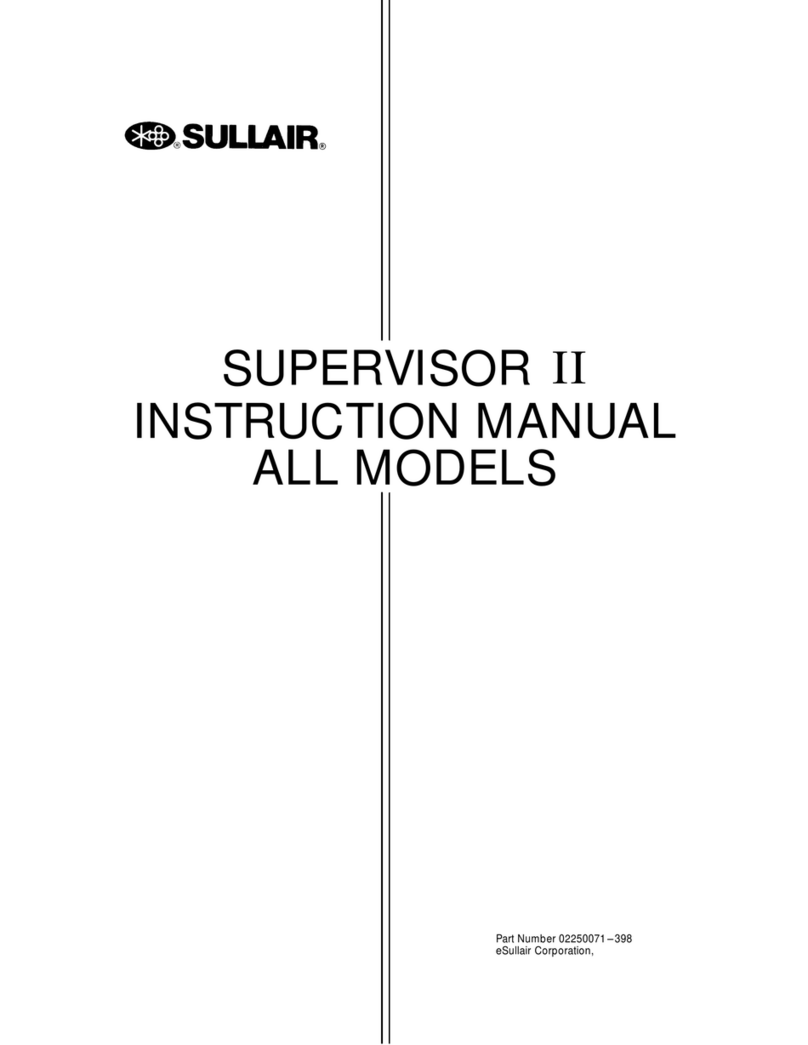
Sullair
Sullair Supervisor II User manual
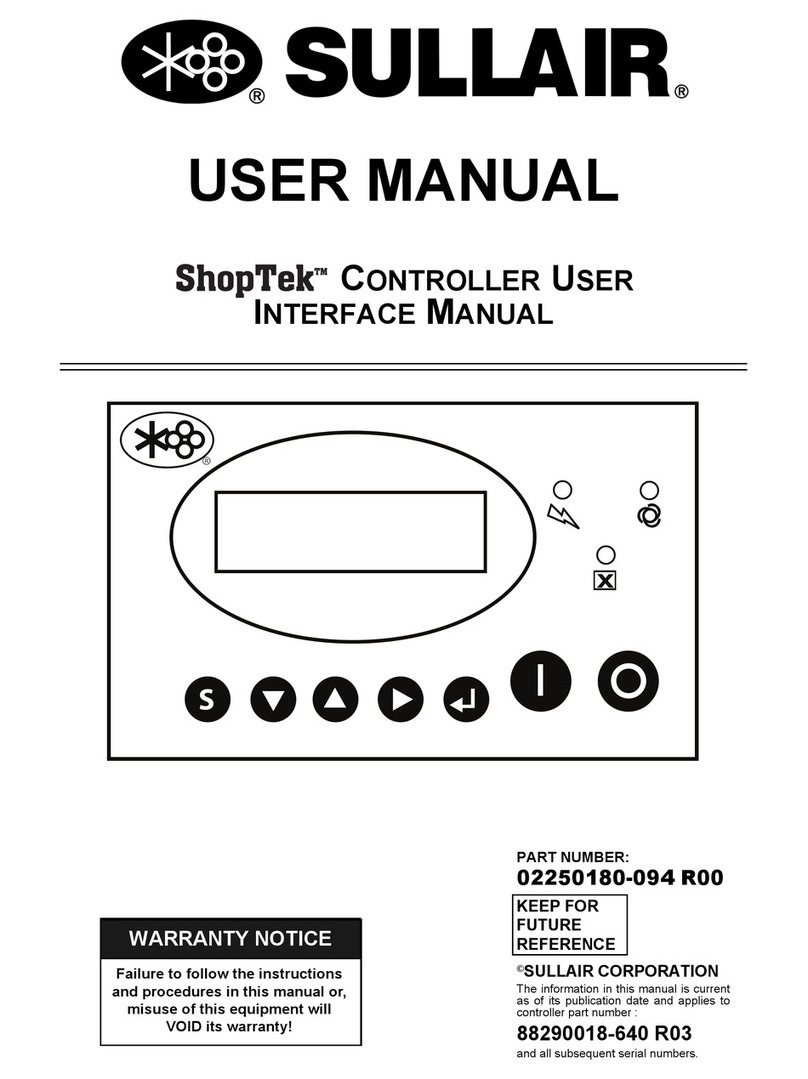
Sullair
Sullair ShopTek User manual
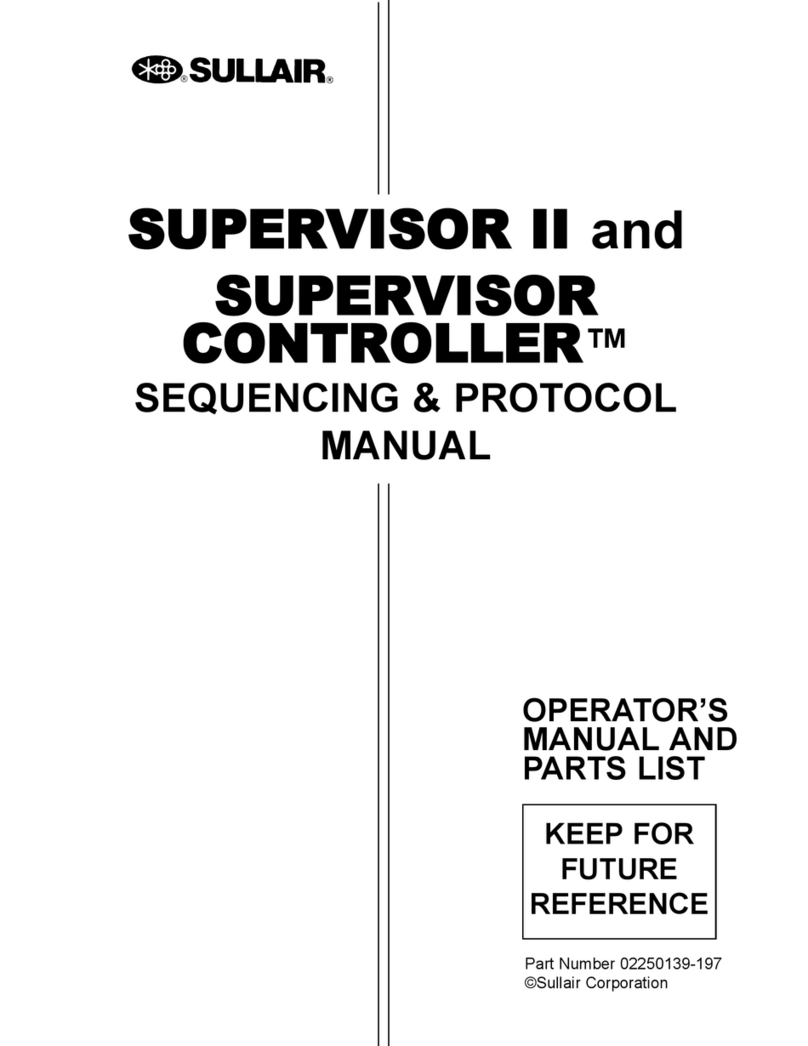
Sullair
Sullair SUPERVISOR II Series User manual

Sullair
Sullair 02250165-411 R01 User manual

Sullair
Sullair EC2000 User manual
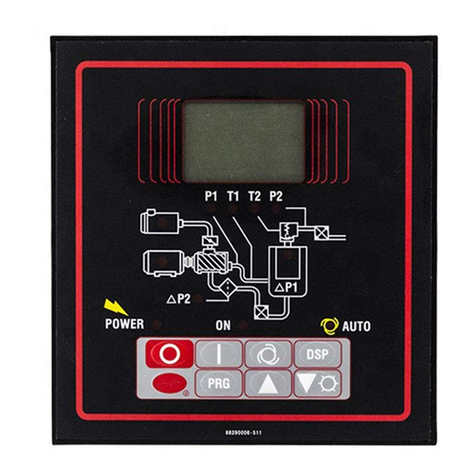
Sullair
Sullair SUPERVISOR CONTROLLER User manual
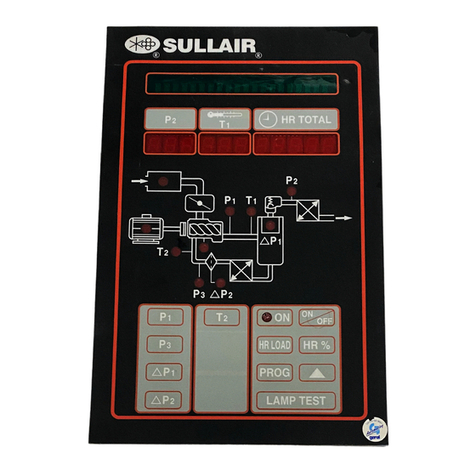
Sullair
Sullair SUPERVISOR CONTROLLER User manual
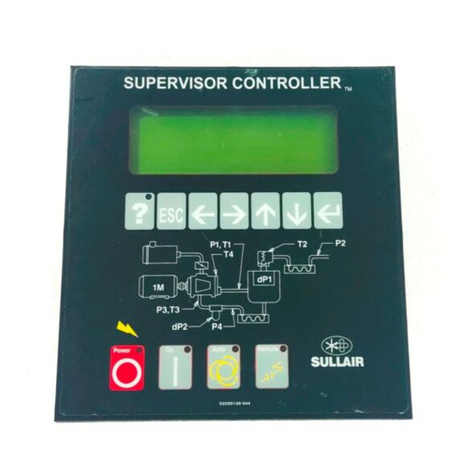
Sullair
Sullair SUPERVISOR CONTROLLER Series User manual

Sullair
Sullair SUPERVISOR CONTROLLER User manual
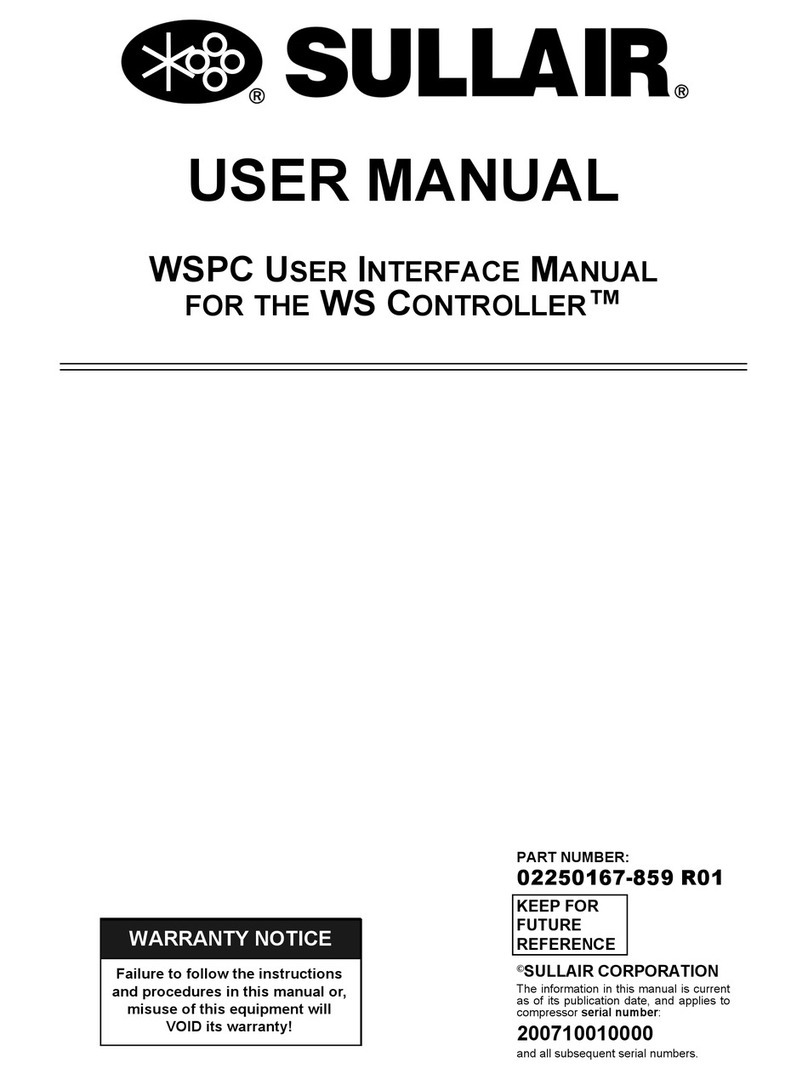
Sullair
Sullair WSPC User manual

